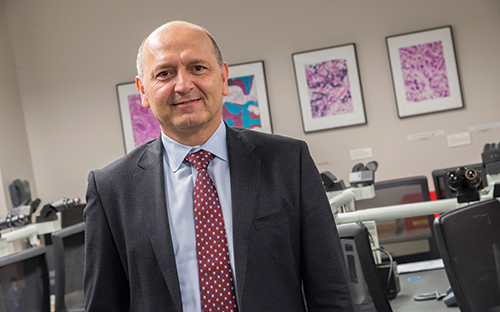
Dr. Netto’s area of interest lies in early detection markers. “We’re beginning to prove that genetic alterations in urine samples tightly mirror those in associated bladder tumors, and we’re finding some encouraging results in terms of developing a very specific assay for a bladder cancer detection screen,” he says. The panel of urine genetic markers is applicable also to surveillance.
He also highlights the work of Ellen Zwarthoff, PhD, in the Netherlands, who is developing DNA-based biomarkers to detect early recurrence. The hope is to create a noninvasive, more accurate alternative to cystoscopy. Most nonmuscle-invasive cancers have activating FGFR3 mutations and telomerase promoter mutations, he explains, and DNA methylation biomarkers are very common in nonmuscle-invasive cancers; Dr. Zwarthoff is developing methods to measure them in voided urine, with an eye toward using them in a surveillance strategy.
Apart from these efforts, researchers are looking at proteomics, microRNAs, and exosomes. “It’s a crowded space,” says Dr. McConkey, with understatement.
He and his colleagues are focusing on markers related to muscle-invasive disease. The reason is simple, says Dr. McConkey: “It’s the lethal form of bladder cancer. And frontline therapies—cystectomy, with or without perioperative cisplatin-based combination chemotherapy—have not changed in decades.”
One of the immediate clinical needs is to determine who needs cystectomy. While bladder preservation is a high priority, “Most of my urology friends, at least here at MD Anderson, would be very concerned about waiting on that,” says Dr. McConkey. “They would rather err on the side of caution. There’s definitely a culture here of cystectomy.”
While there’s level one evidence to suggest benefit of using neoadjuvant cisplatin-based combination chemotherapy in all patients with muscle-invasive disease, the impact on disease-specific survival is only five to 10 percent, he continues. “So our No. 1 priority has been to develop methods to distinguish patients who will benefit from those who won’t.”
Their early attempts involved generating genomic data sets to compare outstanding responders to those who didn’t respond well, and looking for messenger RNAs that were differently expressed by the two groups. They ultimately rejected this approach and next opted “to be more unbiased,” Dr. McConkey says, by generating whole-genome mRNA expression profiling data sets from large cohorts of patients. When they looked at clusters that were generated by subsequent analyses, “Lo and behold, we found that muscle-invasive bladder cancers group into what we now call intrinsic subtypes that share common features with human breast cancers.”
Dr. McConkey now says the approach they chose was a fortunate choice. “It turns out the factors that generate aggressive disease are complicated and probably differ according to a tumor’s intrinsic subtype.” Basal cancers tended to be associated with advanced stage and metastatic disease at clinical presentation. Particularly in the absence of perioperative chemotherapy, they were also the most aggressive, and patients with this subtype had the worst clinical outcome. “In addition, we noticed that these cancers were enriched with squamous and sarcomatoid features, and that they tended to be somewhat more enriched in women.” When they looked at other major variants of bladder cancer, they saw enrichment, in both basal and luminal subtypes, in many of them. “So I think the story here might be that these variants tend to be exaggerated biological versions of the major intrinsic subtypes,” Dr. McConkey says.
Further investigation revealed that a large fraction of the basal subtypes responded to perioperative chemotherapy. “If there’s one patient population we think should definitely get chemotherapy, it’s the population with these basal cancers,” Dr. McConkey says. (That’s also true with breast cancer, he adds—the efficacy of neoadjuvant therapy is highest in the basal and HER2-enriched subtypes. And with a new basal variant having been identified in pancreatic cancer, which might also be more responsive, “We think that being basal might be a sign of being chemosensitive across disease types.”)
The luminal cancers were separated into two distinct subtypes. One was enriched with papillary features and activating mutations in FGFR3; the other was infiltrated with fibroblasts and some lymphocytes, Dr. McConkey says. The latter subtype—referred to by some researchers as “infiltrated” or p53-like (because they had gene expression signatures consistent with active, wild-type p53)—appears to be resistant to neoadjuvant chemotherapy. Looking at additional cohorts, the researchers have validated these observations, Dr. McConkey says. “We found the same patterns to be true every time we looked. They’re not completely resistant in every cohort, but we’re a little concerned that some of the downstaging that’s attributed to neoadjuvant chemotherapy might actually be due to surgery,” he says. It might also be due to a combination of the two.
It’s possible fibroblasts have something to do with chemoresistance, Dr. McConkey says, noting that they’ve been implicated in pancreatic and other cancers and have been associated with tumor quiescence. Further complicating the picture, he says, he and his colleagues have found that a few basal cancers slip into this category, although TCGA analyses found this cluster to be 100 percent luminal. “We don’t think it’s a particularly stable subtype,” he says. Some of the papillary luminal cancers that aren’t downstaged by neoadjuvant therapy “switch over” and become p53-like after chemotherapy. “We worry that this phenotype, if it persists, could undermine attempts to re-treat these patients with other cytotoxic agents.” Again, he draws a possible parallel to luminal A breast cancers, which don’t benefit from neoadjuvant chemotherapy.
While Dr. McConkey’s work is looking through the mRNA lens, others are looking through the DNA perspective at mutations such as ERCC2, ERBB2, ATM, FANCC, and RB1. “There’s good evidence that some of these mutations may also be able to inform the use of neoadjuvant therapy,” he says.
For all the genuine excitement, the current clinical realities are still sobering. “Today, what do we order on every patient routinely?” asks Dr. Netto. “The answer is: nothing.”
Nevertheless, he remains positively chipper about the future. “At no time have I been more optimistic than I have in the last year or two,” Dr. Netto says. “And I will be very surprised in the upcoming year if we don’t start doing a panel of CK20, CK5/CK6, HER2, CD44 expression, and FGFR3 mutation.”
“And,” he adds, “we’re starting to get clinical requests for PD-L1 markers.”
Naturally, new markers will place new demands on pathologists. But Dr. Zhai also suggests that old demands are worth revisiting, too.
That would include the basic diagnostic categories. “We routinely classify bladder cancer into three major groups,” says Dr. Zhai. Superficial disease is either noninvasive or superficially invasive; this is considered to be a low-risk group. “You follow up, you use topical BCG, curettage, or local resectioning—all the things that are less dramatic interventions,” he says. On the other end of the spectrum lies metastatic cancer.

“We’re flooded with companies that want to work with us on FGFR3.”
David McConkey, PhD
In between is muscle-invasive disease. “I wrestle with this,” Dr. Zhai concedes. Muscle involvement can entail either the muscularis mucosae, which is essentially superficial involvement, or muscularis propria. “When oncologists and urologists talk about muscle involvement, they mean muscularis propria.”
Differentiating between the two types can be difficult, says Dr. Zhai. “We can use morphology, we can use immunohistochemistry, and occasionally we can’t tell.
“As a surgical pathologist,” he continues, “I think it is OK to communicate with the clinician: ‘I’m not sure what kind of muscle—we should probably rebiopsy the patient before anything dramatic is done.’ So surgical pathologists don’t write casually, ‘muscle-involving urothelial carcinoma.’”
Pathologists also need to determine if the bladder cancer is indeed urothelial carcinoma. Most cases are, although a minority fall into other categories: stromal tumors, squamous cell carcinoma, and adenocarcinoma, for example. “In the stromal tumor you have sarcoma, but there is also pseudosarcoma,” Dr. Zhai warns. Mistaking the latter for the former can lead to unnecessary cystectomy. Micropapillary variants can also pose a diagnostic problem. Much of the time, such variants are seen when the tumor has already deeply invaded the muscle. If pathologists are unaware of this feature and call the tumor superficially invasive, clinicians will mistakenly treat these patients as if they had low-risk disease.
Micropapillary variants tend to be more aggressive, Dr. Netto says; interestingly, using HER2 as a marker and targeting these variants with Herceptin shows some promise. “It opens clinicians’ eyes to a potential target of therapy,” he says.
Carcinoma in situ has its own challenges. These flat, high-grade lesions by their nature produce very limited amounts of material. “It’s been difficult to do good genomics on them,” says Dr. McConkey. He’s hopeful that technological breakthroughs will push researchers over that barrier soon, however. “I think within the next year we’ll have a better idea of what CIS looks like, whether it looks like muscle-invasive disease, whether it consists of both basal and luminal tumors, whether it’s got unique patterns of DNA alterations, etc.”
Dr. McConkey sees an expanded role for pathologists as a fresh grammar of bladder cancer is established. Variants that are seen under the microscope will likely also be revealed through RNA expression profiling or RNA sequencing, for example. Citing the work of MD Anderson colleague Bogdan Czerniak, MD, PhD, he reports that tumors with squamous cell features, for example, tend to have molecular characteristics consistent with the squamous focus throughout the tumor. Dr. Czerniak has also seen this with sarcomatoid tumors and micropapillary tumors, Dr. McConkey says. The upshot: “From a diagnostic perspective, I think our pathology calls will be a lot more accurate. And I think ultimately our therapeutic decision-making is going to change, based on whether we know the tumor looks squamous, or sarcomatoid, or micropapillary, or small cell, etc.”
Beyond that, of course, identifying the basal/luminal origins of the cancers will likely be critical, Dr. McConkey says. Researchers are already developing tools that will enable pathologists to make those calls without having to perform deep molecular profiling, he says. At a conference in Madrid in March 2015, participants discussed development of an immunohistochemical classifier. The subsequent consortium tasked with doing this hopes to use RNA sequencing to assign large cohorts of tumors from two independent clinical trials; at the same time, they’ll try to make subtype assignments using IHC biomarkers already approved for use in other cancer types, including breast. “So we would hypothesize that using just two antibodies might be sufficient for us to make these calls. If we could assign the tumors to the subtypes using routine immunohistochemistry, that would make this type of assignment accessible everywhere.”
Dr. McConkey, in short, leaves pathologists with a clear message: They have every reason to be excited about new developments in bladder cancer. In fact, they may be the ones leading the way out of the swamp.
Embracing genomics as part of pathologic diagnosis is probably the wave of the future, he says. For some, that spells tension. “I can sense there are sometimes these struggles, kind of an us-versus-them mentality,” Dr. McConkey says. “That’s not helpful.” What pathologists see under the microscope can be understood with genomics, but genomics is not ready to replace pathology, he says. IHC-based testing for anti-PD-1/PD-L1 makes that point loud and clear.
“If anything,” says Dr. McConkey, “this is the time when we need pathologists, more than ever, to be actively involved in this work.” Perhaps bladder cancer is, at long last, emerging from its twin curses of being invisible and being complex. Is this the year?
[hr]
Karen Titus is CAP TODAY contributing editor and co-managing editor.
 CAP TODAY Pathology/Laboratory Medicine/Laboratory Management
CAP TODAY Pathology/Laboratory Medicine/Laboratory Management
